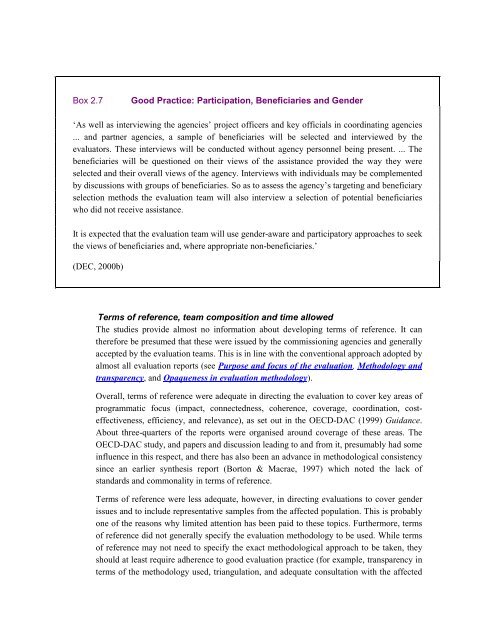Download PDF - ReliefWeb
Download PDF - ReliefWeb
Download PDF - ReliefWeb
Create successful ePaper yourself
Turn your PDF publications into a flip-book with our unique Google optimized e-Paper software.
Box 2.7 Good Practice: Participation, Beneficiaries and Gender<br />
‘As well as interviewing the agencies’ project officers and key officials in coordinating agencies<br />
... and partner agencies, a sample of beneficiaries will be selected and interviewed by the<br />
evaluators. These interviews will be conducted without agency personnel being present. ... The<br />
beneficiaries will be questioned on their views of the assistance provided the way they were<br />
selected and their overall views of the agency. Interviews with individuals may be complemented<br />
by discussions with groups of beneficiaries. So as to assess the agency’s targeting and beneficiary<br />
selection methods the evaluation team will also interview a selection of potential beneficiaries<br />
who did not receive assistance.<br />
It is expected that the evaluation team will use gender-aware and participatory approaches to seek<br />
the views of beneficiaries and, where appropriate non-beneficiaries.’<br />
(DEC, 2000b)<br />
Terms of reference, team composition and time allowed<br />
The studies provide almost no information about developing terms of reference. It can<br />
therefore be presumed that these were issued by the commissioning agencies and generally<br />
accepted by the evaluation teams. This is in line with the conventional approach adopted by<br />
almost all evaluation reports (see Purpose and focus of the evaluation, Methodology and<br />
transparency, and Opaqueness in evaluation methodology).<br />
Overall, terms of reference were adequate in directing the evaluation to cover key areas of<br />
programmatic focus (impact, connectedness, coherence, coverage, coordination, costeffectiveness,<br />
efficiency, and relevance), as set out in the OECD-DAC (1999) Guidance.<br />
About three-quarters of the reports were organised around coverage of these areas. The<br />
OECD-DAC study, and papers and discussion leading to and from it, presumably had some<br />
influence in this respect, and there has also been an advance in methodological consistency<br />
since an earlier synthesis report (Borton & Macrae, 1997) which noted the lack of<br />
standards and commonality in terms of reference.<br />
Terms of reference were less adequate, however, in directing evaluations to cover gender<br />
issues and to include representative samples from the affected population. This is probably<br />
one of the reasons why limited attention has been paid to these topics. Furthermore, terms<br />
of reference did not generally specify the evaluation methodology to be used. While terms<br />
of reference may not need to specify the exact methodological approach to be taken, they<br />
should at least require adherence to good evaluation practice (for example, transparency in<br />
terms of the methodology used, triangulation, and adequate consultation with the affected
















![CynefinFramework final [Read-Only]](https://img.yumpu.com/19017304/1/190x135/cynefinframework-final-read-only.jpg?quality=85)